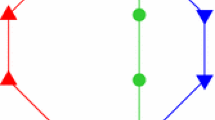Abstract
The classic problem of counting monomer-dimer arrangements on a two-dimensional lattice is analyzed using techniques from theoretical computer science. Under a certain assumption, made precise in the text, it can be shown that the general problem is computationally intractable. This negative result contrasts with the special case of a system with monomer density zero, for which efficient solutions have been known for some time. A second, much easier result, obtained under the same assumption, is that the partition function of a three-dimensional Ising system is computationally intractable. Again, the negative result contrasts with known efficient techniques for evaluating the partition function of a two-dimensional system.
Similar content being viewed by others
References
M. E. Fisher, Statistical mechanics of dimers on a plane lattice,Phys. Rev. 124:1664–1672 (1961).
M. E. Fisher, On the dimer solution of planar Ising models,J. Math. Phys. 7:1776–1781 (1966).
R. H. Fowler and G. S. Rushbrooke, Statistical theory of perfect solutions,Trans. Faraday Soc. 33:1272–1294 (1937).
M. R. Garey and D. S. Johnson,Computers and Intractability—A Guide to the Theory of NP-Completeness (Freeman, 1979).
O. J. Heilmann and E. H. Lieb, Theory of monomer-dimer systems,Commun. Math. Phys. 25:190–232 (1972).
J. E. Hopcroft and J. D. Ullman,Introduction to Automata Theory, Languages and Computation (Addison-Wesley, 1979).
M. R. Jerrum, The complexity of evaluating multivariate polynomials, Ph. D. Thesis CST-11–81, Department of Computer Science, University of Edinburgh, (1981).
P. W. Kasteleyn, Dimer statistics and phase transitions,J. Math. Phys. 4:287–293 (1963).
P. W. Kasteleyn, Graph theory and crystal physics, inGraph Theory and Theoretical Physics, F. Harary, ed. (Academic Press, 1967), pp. 43–110.
J. K. Percus,Combinatorial Methods (Applied Mathematical Sciences 4, Springer-Verlag, 1971).
J. E. Savage,The Complexity of Computing (Wiley, 1976).
H. N. V. Temperley and M. E. Fisher, Dimer problem in statistical mechanics—An exact result,Phil. Mag. 6:1061–1063 (1961).
L. G. Valiant, The complexity of computing the permanent,Theor. Computer Sci. 8:189–201 (1979).
L. G. Valiant, The complexity of enumeration and reliability problems,SIAM J. Computing 8: 410–421 (1979).
Author information
Authors and Affiliations
Rights and permissions
About this article
Cite this article
Jerrum, M. Two-dimensional monomer-dimer systems are computationally intractable. J Stat Phys 48, 121–134 (1987). https://doi.org/10.1007/BF01010403
Received:
Revised:
Issue Date:
DOI: https://doi.org/10.1007/BF01010403



